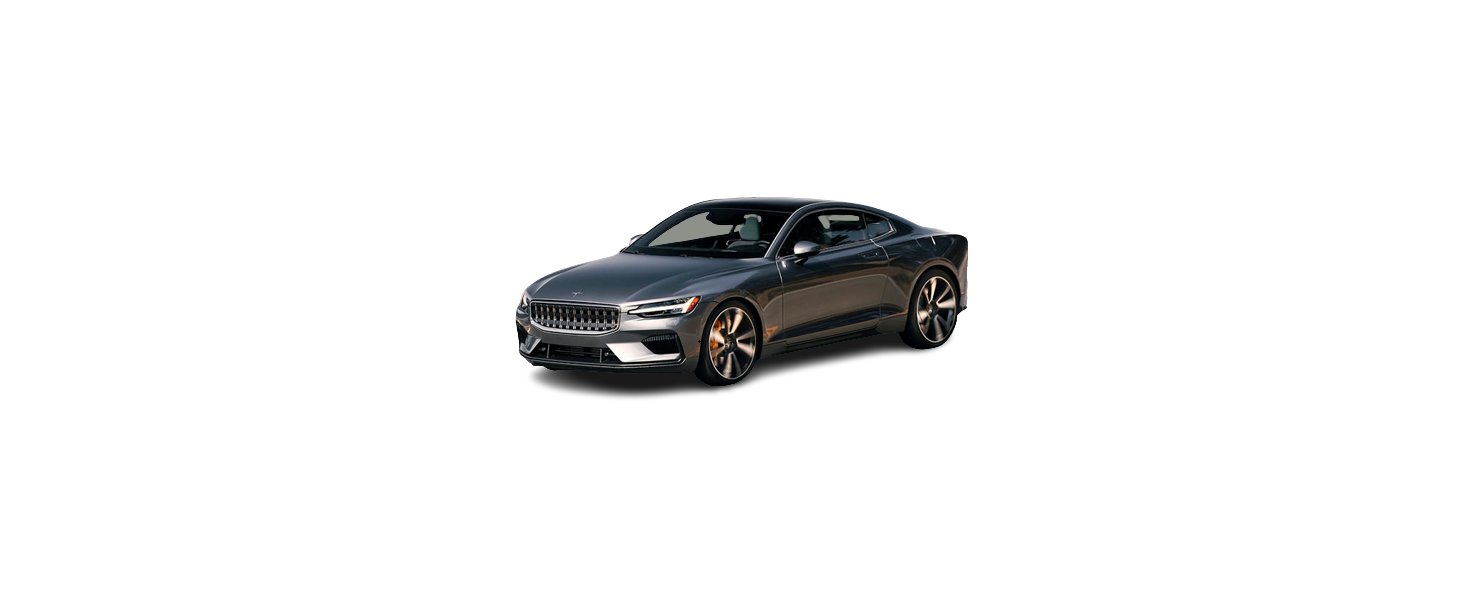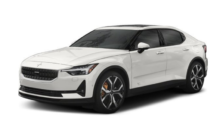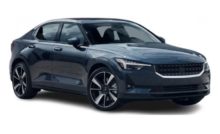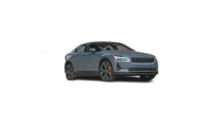Drive modes
Drive modes enable easy access to the vehicle’s many functions and settings in different driving situations. Each drive mode is adapted to help optimize driving characteristics.
- Steering
- Engine/transmission/all-wheel drive
- Brakes
- Instrument panel
- Climate control settings
Select the drive mode that is adapted to the current driving conditions. Keep in mind that not all drive modes are available in all situations.
Available drive modes
Please be aware that there is no sound from the engine when the vehicle is being powered on electricity and it may be difficult to detect by children, pedestrians, cyclists and animals. This is particularly true at low speeds, e.g. in parking lots.
Do not leave the vehicle in an unventilated area with a drive mode activated and the combustion engine switched off. The engine will start automatically if the charge level in the hybrid battery is low and the resulting exhaust gases can be very harmful to people and animals.
Hybrid
- This is the vehicle’s normal mode when the two electric motors and the combustion engine are working together.
The vehicle starts in Hybrid mode. The control system uses both the electric motor and the gasoline engine – separately or in tandem – and adapts utilization with regard to performance, fuel consumption and comfort. Driving capacity on the electric motors alone is determined by factors such as the hybrid batteries’ charge level, the need for heating or cooling in the passenger compartment, etc.
With a well-charged hybrid battery, it is possible to drive solely on electric power. When the accelerator pedal is pressed, only the electric motors will be activated until the batteries reach a certain charge level. Above this level, the current in the battery cannot supply the power requested by the accelerator pedal and the combustion engine will start.
When the hybrid battery’s charge level is low, the combustion engine will start more frequently to save the remaining current in the battery. Rapid-charge the vehicle or charge the hybrid battery from a 120-240 V outlet using the charging cable. Alternatively, activate Charge in Function view to restore the ability to drive using only electric propulsion.
This drive mode is designed for low energy consumption with a mix between the electric motor and gasoline engine, without compromising on climate comfort or driving experience. When faster acceleration is requested by the driver, the electric driveline will be utilized to help provide maximum additional power.
The vehicle also monitors the driving conditions and automatically engages all-wheel drive if necessary. All-wheel drive and extra electric power are always available regardless of the battery’s charging status.
Information in the instrument panel
When driving in Hybrid mode, a hybrid gauge will be displayed in the instrument panel. The gauge will indicate the amount of electrical current required when the driver depresses the accelerator pedal. The marker between the lightning and the drop shows how much current is available.
The instrument panel gauge when both the electric motor and the combustion engine are being used.
Pure
- Uses the electric motors only, with the lowest possible energy consumption and lowest possible carbon dioxide emissions.
This drive mode is fully electric and the vehicle is propelled using the rear-axle electric motors, which means that the vehicle is rear-wheel driven.
This drive mode may be unavailable
- if the vehicle’s speed goes above 160 km/h (100 mph)
- if the hybrid battery charge level is too low
- if factors such as cold weather affect the system or components.
Pure mode is adapted for the longest possible driving distance with electric propulsion and is primarily intended for use in city driving. This drive mode does not offer four-wheel drive. This can cause some limitations in poor road conditions or cold weather.
Constant AWD
- Improves the vehicle’s traction and handling by increasing all-wheel drive.
This drive mode locks the vehicle in all-wheel drive. An adapted distribution between front and rear axle torque provides effective control, stability and traction, e.g. on slippery roads or when towing another vehicle. The Constant AWD drive mode is always available regardless of the hybrid battery’s charge status.
Both the combustion engine and the electric motors are engaged to enable all-wheel drive, which results in higher fuel consumption.
In drive modes other than Pure mode, the vehicle automatically adapts the need for all-wheel drive according to the road surface, and can activate the electric motors or start the gasoline engine as needed.
Power
- The vehicle gets sportier driving characteristics and a faster acceleration response.
This drive mode adapts the combined power from the combustion engine and the electric motors by providing power to both the front and rear wheels. Gear shifting will be faster and more distinct and the transmission will prioritize gears with a higher traction force.
Both the combustion engine and the electric motors are engaged to enable all-wheel drive, which results in higher fuel consumption.
This drive mode is adapted for optimal performance and response during acceleration. It changes the throttle response, gear shifting program and turbo boost system. Brake response is also adapted. The Power drive mode is always available regardless of the hybrid battery’s charge status.
Individual
- Customizes drive mode to personal preferences.
Select one of the drive modes as a basis and adjust the settings to achieve your preferred driving characteristics. These settings will be stored in your driver profile.
Individual drive mode is only available if it has been activated in the center display.
Settings view for Individual drive mode.
- Tap Settings in the Top view.
- Tap and select Individual Drive Mode.
- Under Presets, select one of the following drive modes as a basis: Pure, Hybrid or Power.The following settings can be modified:
- Driver Display
- Steering Force
- Powertrain Characteristics
Using the electric or combustion engineAn advanced control system determines the distance that the vehicle can be driven on the combustion engine, electric motors, or all three at the same time.
Its primary function is to use the motor/engine and the current available in the hybrid battery as efficiently as possible based on the characteristics of the various drive modes and the power output requested by the driver by pressing the accelerator pedal. In certain cases, temporary limitations in the system or mandatory functions to help maintain a low overall emissions level may result in greater use of the combustion engine.
Drive systems
Two drive systems
Depending on the selected drive mode and power available in the electric motors, the drive systems can either be used separately or in tandem.
The electric motors are supplied current from the hybrid batteries. One is located in the tunnel console and the other behind the rear seat in the trunk. The hybrid batteries can be charged from wall outlets or at a special charging station. The gasoline engine can also charge the hybrid batteries using a special high-voltage generator.
Both the gasoline engine and the electric motors can generate power directly to the wheels. An advanced control system coordinates both the drive systems to help optimize driving economy.
- Hybrid batteries – The vehicle is equipped with two hybrid batteries. The function of the hybrid batteries is to store energy. This energy is provided by plugging the charging cable into an electrical outlet, through regenerative braking or from the high-voltage generator. The batteries provide energy for electric propulsion and e.g. preconditioning.
- Gasoline engine – The gasoline engine starts when the charge level in the hybrid batteries is too low to provide the power output requested by the driver.
- High-voltage generator (CISG (Crank Integrated Starter Generator) – combined high-voltage generator and starter) The high-voltage generator charges the high-voltage batteries. It also functions as a starter motor for the gasoline engine. Can provide the combustion engine with extra electrical current.
- Electric motors – The vehicle is equipped with two electric motors that power the vehicle in electric mode. They provide extra torque and power during acceleration as well as electric four-wheel drive functionality. The electric motors provide adapted power to each rear wheel for extra stability,(Torque vectoring) for example when cornering. They regenerate braking energy into electrical current.
General information about the hybrid operation
The instrument panel displays information specific to hybrid operation – charging information, selected drive mode, distance to discharged battery and charge level of the hybrid batteries.
Different drive modes can be selected while driving, e.g. electric power only or, if more power is needed, a combination of electric and combustion power. The vehicle calculates a combination of driveability, driving experience, environmental impact and fuel economy for the selected drive mode.
In order to function optimally, the hybrid batteries (and their electrical drive systems) and the gasoline engine (and its drive systems) must be at the correct operating temperature. Battery capacity can be considerably reduced if the batteries are too cold or too hot. Preconditioning prepares the vehicle’s drive systems and passenger compartment before driving to help reduce both wear and energy consumption. The range for the hybrid batteries increases.
The hybrid batteries, which drive the electric motor, are charged via a charging cable but can also be charged by gentle braking and engine braking in gear selector position B. The combustion engine can also help recharge the hybrid batteries.
Important
No electrical current
Keep in mind that if there is no electrical current to the vehicle, i.e. the ignition is switched off or the start battery is discharged, certain important functions such as power brakes, power steering, etc. will be limited.
The power brakes only work when the vehicle is switched on.
Towing not permitted
Never tow a hybrid vehicle behind another vehicle, as this could damage the electric motors.
Exterior engine noise
Please be aware that there is no sound from the engine when the vehicle is being powered by the electric motors and it may be difficult to detect by children, pedestrians, cyclists and animals. This is especially true at low speeds.
High-voltage electrical current
A number of electrical components in the vehicle use high-voltage current and can be extremely dangerous if handled incorrectly. These components and any orange wiring in the vehicle may only be handled by trained and qualified Polestar service technicians. Do not touch anything that is not clearly described in the Manual.
Holland Charge functions
The functions can be activated in the center display’s Function view.
Hold
This function retains the charge in the hybrid battery for the electric motor and saves available electrical current for use at a later time, such as when driving in an urban area or residential neighborhood.
The vehicle will function as in normal hybrid driving with a discharged battery – in addition to reusing energy from e.g. regenerative braking, the combustion engine will be used more frequently to maintain the charge in the battery.
Charge
This function charges the hybrid battery with the help of the combustion engine for increased use of the electric motor at a later time.
Symbols in the instrument panel
The
The
Hybrid batteries
Some parts of the rear hybrid batteries are visible through a clear panel in the trunk. Only authorized workshop personnel may handle hybrid batteries.
The vehicle cannot be started if the hybrid battery is discharged.
If both the start battery and the hybrid battery are discharged, both batteries must be recharged. In this situation, it is not possible to first charge only the hybrid battery. The start battery must have a certain charge level in order for the hybrid battery to be charged.
Only a workshop may replace a hybrid battery – contact Polestar Customer Support.
Hybrid battery service life and capacity
The capacity of the hybrid battery decreases with age and use, which could result in increased use of the combustion engine, leading to higher fuel consumption and reduced electric motor range.
Coolant
The hybrid battery’s cooling system has its own expansion tank.
The hybrid battery’s coolant should only be refilled by a workshop – contact Polestar Customer Support.
Specifications for hybrid battery
Type: Lithium-ion
Power reserve: 34 kWh.
Hybrid battery gauge
The current in the hybrid battery is used to power the electric motors, but can also be used to heat or cool the vehicle. The trip computer calculates an approximate driving distance with the remaining current in the hybrid battery.
Symbols in the hybrid battery gauge
The
Hybrid gauge
The hybrid gauge shows the ratio between the electric motors’ current power consumption and the remaining available power. This information is shown in various ways.
Symbols in the hybrid gauge
Driver-requested power
The hybrid gauge displays the amount of power requested (utilized) by the driver through pressure on the accelerator pedal. The higher the reading on the scale, the more power utilized in the current gear. The mark between the lightning symbol and the drop symbol indicates the point at which the combustion engine will start.
The vehicle has been started, but is stationary and no power is being requested.
The electric motor cannot supply the requested power and the internal combustion engine will start.
The vehicle is generating current to recharge the battery, e.g. during light braking or engine braking on a downslope.
| Symbol | Message | Meaning |
|---|---|---|
| | 12 V Battery Charging fault, service urgent. Drive to workshop | Hybrid battery fault. Contact Polestar Customer Support to have the battery checked as soon as possible. |
| | 12 V Battery Charging fault Stop safely | Hybrid battery fault. Stop the vehicle as soon as possible and contact Polestar Customer Support to have the battery checked. |
| | 12 V Battery Fuse failure Service required | Hybrid battery fault. Contact Polestar Customer Support to have the system checked as soon as possible. |
| | HV battery Overheated, stop safely | The hybrid battery’s temperature seems to be rising at an abnormal rate. Stop the vehicle and turn off the engine. Wait at least 5 minutes before driving. Contact Polestar Customer Support or inspect the vehicle to make sure everything seems normal before continuing to drive. |
| | Reduced performance Max vehicle speed limited | The hybrid battery’s charge level is too low for driving at high speeds. Charge the battery as soon as possible. |
| | Propulsion system Harsh behavior at low speed, vehicle ok to use | The hybrid system is not functioning properly. Contact Polestar Customer Support to have the system checked as soon as possible. |
| | Hybrid system failure Service required | The hybrid system is not functioning. Contact Polestar Customer Support to have the system checked as soon as possible. |
| | Charge cable Remove before start | Displayed when the driver attempts to start the vehicle with the charging cable still connected. Remove the charging cable and close the charger cover. |
Recommendations for long-term storage
Do as follows:
- If the hybrid battery charge level is high, drive the vehicle until the charge level is approximately 25%. If the charge level is low, charge the batteries until the level reaches approximately 25%.
- If the vehicle is not driven for more than 6 months or the charge level of the hybrid batteries is noticeably below the 25% mark, charge the batteries to about 25% to help compensate for the natural battery discharge that occurs in long-term storage. Regularly check the charge level using the gauge in the instrument display.
Store the vehicle in as cool a location as possible to minimize batteries aging during long-term storage. In the summer, park the vehicle indoors or in a shady location, whichever is cooler. The recommended tire inflation pressure during long-term storage is 330 kPA (48 PSI). Check the inflation pressure of the tires and adjust to the correct pressure, which can be found on the vehicle’s tire information decal or certification label.
Starting and stopping the gasoline engine
Climate settings at low temperatures
At low ambient temperatures, the combustion engine will sometimes start automatically to help achieve the desired passenger compartment temperature and air quality. The amount of time the combustion engine is running can be affected by
- lowering the temperature
- reducing blower speed
- activating Pure drive mode.
Using the electric motor in hot or cold weather
At very low or high ambient temperatures, the electric motor’s driving range and power may be reduced and affect how often the combustion engine automatically starts.
Emission control system
To help ensure that the emission control system is as energy-efficient as possible, the combustion engine will run for several minutes after it is started. The amount of time the combustion engine needs to be used varies depending on the temperature of the three-way catalytic converter.
California Proposition 65
Operating, servicing and maintaining a passenger vehicle can expose you to chemicals including engine exhaust, carbon monoxide, phthalates, and lead, which are known to the State of California to cause cancer and birth defects or other reproductive harm. To minimize exposure, avoid breathing exhaust, do not idle the engine except as necessary, service your vehicle in a well ventilated area and wear gloves or wash your hands frequently when servicing your vehicle. For more information go to www.P65Warnings.ca.gov/passenger-vehicle.




